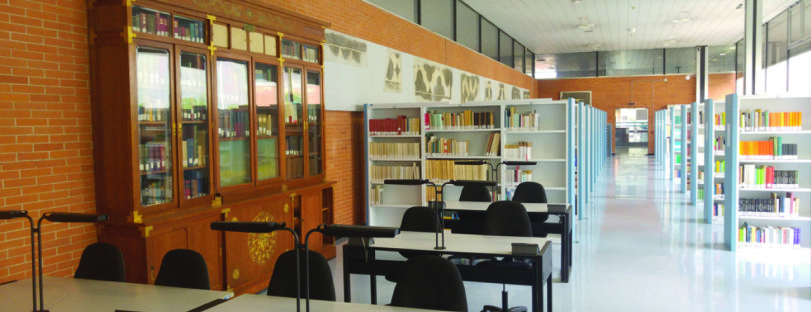“IsIAO” LIBRARY – NATIONAL CENTRAL LIBRARY OF ROME
AFRICAN AND ORIENTAL COLLECTIONS ROOM

Biblioteca Nazionale Centrale di Roma – Sala delle Collezioni Africane e Orientali
AFRICAN AND ORIENTAL COLLECTIONS ROOM
Opening hours:
Tuesday 8.30 am -1.30 pm
Wednesday 8.30 am -1.30 pm
Thursday 8.30 am -1.30 pm
Contacts:
Viale Castro Pretorio 105, 00185 Rome
tel. +39 (0)6 4989373; email: biblioteca.isiao@gmail.com
ISMEO tel. +39 (0)6 89537445
IsIAO: HISTORICAL NEWS
The Italian Institute for Africa and the Orient (IsIAO) was established by law no. 505 of 25 November 1995, which merged two internationally renowned institutes founded during the first part of the twentieth century, the Italo-African Institute (IIA) and the Italian Institute for the Middle and Far East (IsMEO), and it continued to pursue goals of the two institutes and safeguard their wealth of skills and experience. The ISIAO was shut down, for economic reasons, with joint provision of the Ministry of Economy and Finance and Foreign Affairs on 11 November 2011. The museum heritage of the closed institute was entrusted by the Ministry of Foreign Affairs (its vigilant body) to the Museo delle Civiltà (MuCiv), while the Library, Map Library and Photo Library were temporarily assigned to the National Central Library of Rome (BNCR).
ISMEO – International Association of Mediterranean and Oriental Studies, established in 2012 with the aim of continuing the scientific work of the closed IsIAO, contributes to the reorganisation and updating of the Library, while waiting for the complete collection to be looked after by one foundation. Funds for this have been specifically allocated by the Ministry of Education, University and Research Project “Studies and research on the cultures of Asia and Africa: tradition and continuity, revitalisation and dissemination”, in agreement with the National Central Library of Rome (BNCR) and with the scientific collaboration of the Association for African Studies in Italy (ASAI).
LIBRARY
It has over 200,000 volumes, 2,500 periodicals of which 500 are ongoing (to 2012), manuscripts, woodblock prints, maps and photographs.
African section
It is the oldest section specialising in African studies in Italy. Its creation, together with that of the Italian Colonial Institute, in 1906, was intended to correspond to the need for a body that provided information on the problems of the overseas lands and the formation of a colonial conscience.
Set up as a bibliographic orientation centre for the European colonial experience, the library documents Italian policies in Africa, i.e. policies of exploration and colonisation and, with regard to Somalia, preparation for independence and cooperation. It is therefore one of the most important Italian libraries on the African continent and, for original documentation related to Eritrea, Ethiopia, Libya and Somalia, one of the most important in the world. There are a small number of assets in Oriental languages (Arabic, Ge’ez, Amharic, Tigrinya and Tigris) in the collection.
Oriental section
It is a continuation of the library of the Italian Institute for the Middle and Far East (IsMEO) founded in 1934. It specialises in ancient and modern oriental studies and collects works on historical, archaeological, philosophical, historical-religious, linguistic, philological and literary subjects, particularly concerning Central and South Asia and the Far East.
Of great importance is the Giuseppe Tucci fund, consisting of the private library donated by the distinguished orientalist and composed of about 25,000 works including a rich collection of Tibetan and Sanskrit texts (silographic prints and manuscripts), collected by Tucci during his travels in Tibet, a large number of Buddhist texts in Chinese and a remarkable collection of works on India and Tibet. Special mention must be made of the Chinese fund, the microfilm section of Tibetan and Chinese Dunhuang manuscripts, rare texts of the Beijing National Library now in Taipei (11 km of film) and Chinese scientific periodicals. Other funds kept in the Institute’s library include a fund donated by the Japanese Embassy in Italy, the Giacinto Auriti, Salvatore Mergè, Lamberto Ricci funds (specialists on the Far East), the Pietro Quaroni fund (India specialist), the Emilio Dubbiosi fund (works, mostly manuscripts, in Arabic currently being catalogued) and the Maurizio Taddei fund (archaeology and art history of India).
Photographic library
It holds a remarkable and, in many respects, an invaluable and irreplaceable collection of images on Africa and Asia. This is certainly true for Eritrea, Ethiopia, Libya and Somalia starting from the very first years of Italian presence in Africa. This photographic documentation, largely inherited from the Italian Ministry for Africa, brings together not only “official” material, but also interesting photographs by individuals (professional and amateur photographers, missionaries and military personnel, travellers and anthropologists). The collection is estimated at around 100,000 photographic prints, 20,000 negatives on a glass plate and several hundred on film and is completely catalogued with regard to the Ethiopia-Eritrea section.
The eastern photographic collections include around 500,000 documents from the Institute’s missions. Of these, 14,000 form the photographic archive of Giuseppe Tucci’s expeditions in the Himalayan region. The fully catalogued Himalayan archive also contains unique footage of Tibetan monuments that no longer exist. The Asian photographic material, together with the archive of about 19,000 drawings mostly large format (topographic and stratigraphic surveys and drawings of archaeological pieces), is temporarily deposited at the MuCiv (Museo della Civiltà).
Map Library
It has about 3,000 maps with a total of 14,000 sheets, mostly inherited from the Cartographic Service of the Italian Ministry for Africa, established in 1914 with a documentary function within the ministerial structure. The collection includes the official Italian cartographic production of the Military Geographic Institute and the Navy Hydrographic Institute and, to a lesser extent, Italian and foreign private map production. The very dated material, with a predominantly historical significance, is the most significant of its kind in Italy. The time span goes from the penultimate decade of the 1800s to the 1950s.

